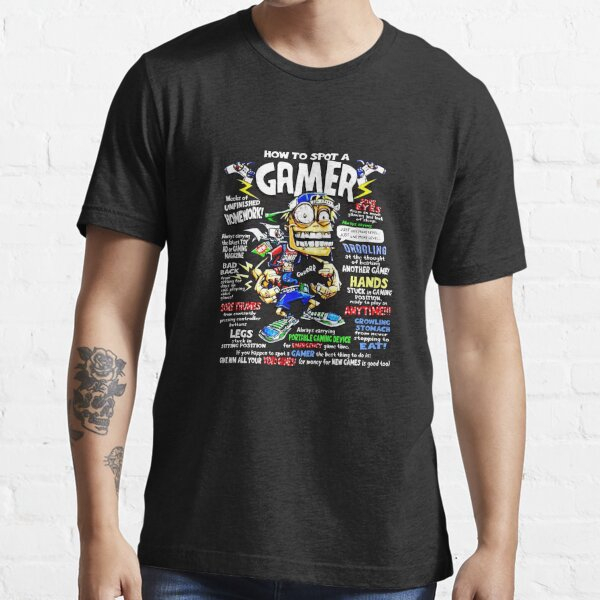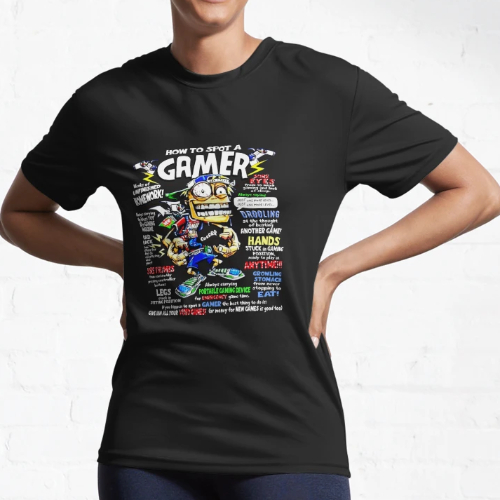- Bio
-
Understanding Gaming Stereotypes: What the How To Spot Gamer Shirt Represents
The humorous How To Spot A Gamer T Shirt pokes fun at the stereotypes surrounding gaming culture with an exaggerated cartoon character proudly donning tech accessories. This shirt allows gamers to broadcast their identity while acknowledging cultural narratives. For non-gamers, it can serve as an icebreaker for meaningful conversations. This article focuses on exploring the implications of gamer stereotypes and how apparel like this both critiques and celebrates gaming passions.
The Shirt Design Elements: A Visual Commentary on Gaming Culture
To have a better understanding of the messages behind the shirt design, the first and foremost thing to do is look at deeply the design elements. Actually, it’s a visual commentary on gaming culture.
1.1. Analyzing the Cartoon Character and Design Aesthetics
What stands out on this shirt is a cartoon character. The character has a thin body, sunken eyes, and a hunched back. It wears mismatched clothes printed large on the shirt. The character has electronic devices as accessories too. There are devices on a hat, backpack, and shoes. This shows a passion for tech gadgets.
The exaggerated features play into stereotypes of gamers. It shows what some think gamers look like if they play too much. Things like bad posture and dark circles under the eyes show an unhealthy lifestyle. But the bright colors and fun vibe make the character nice and funny.
Read More: The Impact Of Gaming On Lifestyle: Reflections From The How To Spot A Gamer Shirt

The shirt design acts as a visual commentary
1.2. The Role of Humor in the Shirt’s Messaging
The cartoon character is surrounded by phrases. Phrases like "weeks of unfinished homework" and "always carrying the latest toy ad." Other phrases are "sore eyes from gaming and lack of sleep" and "hands stuck in gaming position." There are also phrases like "ready to play anytime" and "growling stomach from never stopping to eat."
These exaggerated phrases joke about the idea that gamers are addicted. They only think about games. Listing these extreme traits makes fun of the obsessed gamer stereotype. But the humor feels celebratory, not mocking. Embracing the jokes lets gamers take back these stories.
The Stereotypes Associated with Gamers: A Critical Examination
Some prevalent stereotypes about gamers portray them as socially isolated, only interested in games, and unable to balance real life. They may be seen as unhealthily obsessed or even addicted, ignoring hygiene, sleep, or nutrition.
Gamers are also often stereotyped as highly intelligent but unmotivated, choosing to game rather than applying themselves. Many assume gamers are male, despite nearly half being women. All descriptive phrases in the How To Spot A Gamer Shirt LionKingShirt partly show certain stereotypes about gamers.
These stereotypes likely originate from representations of geeks and nerds in media as well as outdated societal attitudes. Early studies linking aggression with games also contributed to concerns. However, research now suggests gaming builds social, cognitive, and coping skills. However, representations of the unhealthy gamer addicted to the virtual world persist in popular culture. This shapes public perceptions.
When internalized, these stereotypes can negatively impact gamers' self-image. Viewing themselves through this lens can foster self-stigmatization rather than pride in an enjoyable hobby. Feeling judged by friends and family for their gaming interests may isolate gamers.
Assumptions that gamers are lazy, antisocial, and uninterested in broader pursuits can become self-fulfilling prophecies. Stereotypes also affect how gamers are perceived in school, careers, and society, creating barriers.
Within gaming communities, harmful competitiveness and aggression may arise from attempting to uphold the "gamer skill" stereotype. Women and casual gamers can feel unwelcome due to the perception that most gamers are hardcore and male.
Find More Info: How To Spot A Gamer Shirt: Show Off Your Gaming Passion in Style

The shirt shows lots of stereotypes of gamers
Overall, these representations distance gamers from mainstream culture rather than making gaming accessible.
The Cultural Significance of the How To Spot Gamer T-Shirt
Wearing the How To Spot Gamer t-shirt lets people proudly show their gamer identity. It also accepts the stereotypes. The over-the-top cartoon humorously shows how society may see gamers. Owning these extreme traits says the wearer is in on the joke. It doesn't make them ashamed. This turns stigma into a funny group identity. Just wearing the gamer tee is a small act of self-acceptance.
The shirt can also connect gamers with non-gamers. The fun, exaggerated design catches the eye. It starts conversations naturally.
The wearer gets to introduce concepts like gaming addiction and culture more accessible through humor. This makes non-gamers more comfortable asking questions and showing interest. Both sides can find a connection over the mutual understanding stereotypes aren't always accurate. These conversations evoked through the How To Spot A Gamer Shirt help build relationships that transcend hobbies and demographics.
To conclude, the How To Spot Gamer tee playfully jokes about the assumptions of gaming and gamers. The exaggerated stereotypes are funny. But they also highlight wrong ideas that need looking at. Humor lets gamers proudly own their identity. The shirt lightheartedly connects gamer and non-gamer groups. It helps them understand each other.
No one caricature represents gaming culture. Gaming keeps changing and persifying. Looking past stereotypes lets us see gaming and gamers as human, creative, and connected. At its best, the welcoming community empowers all. It lets everyone proudly share the inviting gamer identity.
ramiro elliot
Employer
I do not have any achievements yet
I do not have any feedback yet
I am not participating in any projects yet
